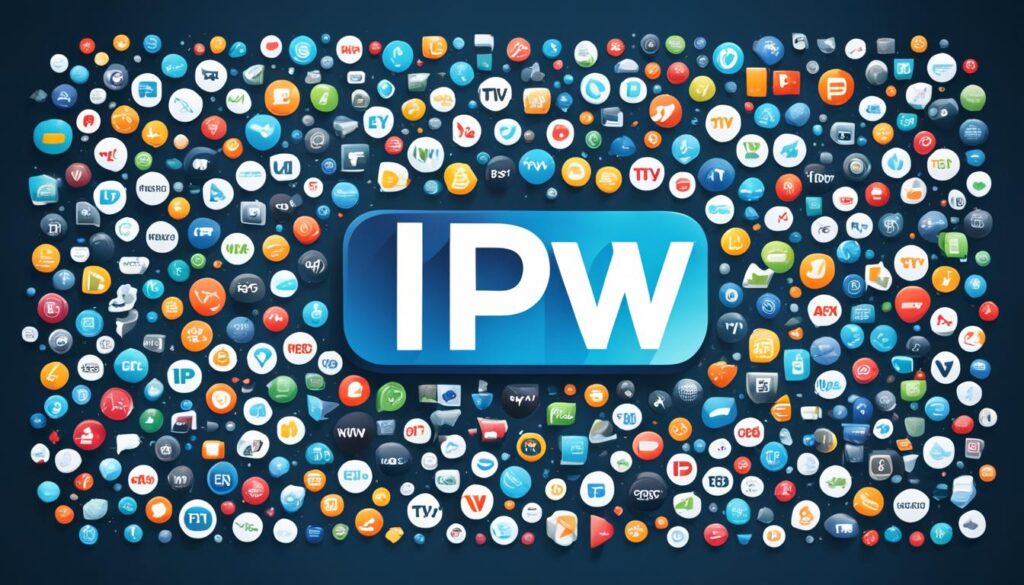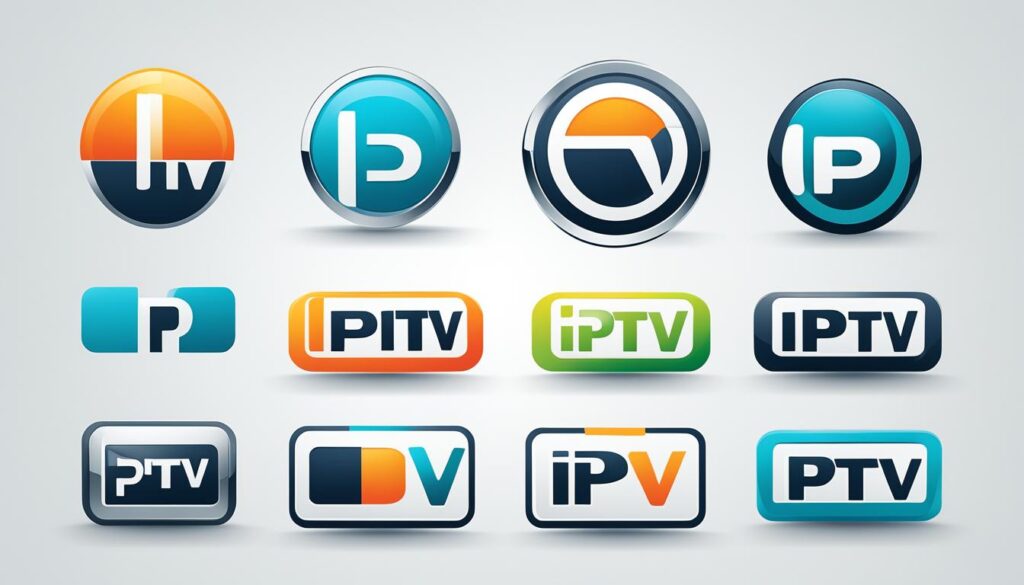Did you know that the global market for IPTV services is projected to reach multimillion dollars by 2031? With a staggering CAGR of 16.8% during the forecast period, the demand for IPTV, or Internet Protocol Television, is on the rise. IPTV has revolutionized the way we consume media, offering a wide range of streaming services, digital entertainment, and online video platforms right at our fingertips.
Key Takeaways:
- IPTV services provide a convenient and personalized way to access media content.
- The market is driven by the increasing demand for streaming services and smart TV technology.
- Subscription video-on-demand and the shift from traditional TV are major drivers of market growth.
- The market is categorized into subscription-based and subscription-free IPTV services.
- North America, Europe, and Asia-Pacific are the leading regions in terms of market growth.
IPTV Services Market Overview
The IPTV services market is witnessing significant growth, with a projected CAGR of 11.6% between 2024 and 2031. This robust market growth is being driven by the increasing demand for video-on-demand, time-shifted television, and live television services. As consumers increasingly seek flexible and convenient options for accessing a wide range of content, IPTV services have emerged as a popular choice for media consumption.
The market size for IPTV services is expected to reach multimillion dollars by 2031, with North America and Europe playing crucial roles in driving global market growth. These regions are characterized by high internet penetration rates and a strong presence of key market players, including China Telecom, China Unicom, KT, Orange France, Free France, AT&T, Verizon, SK Broadband, and Telefonica Spain.
Technological innovation and advancement are key factors influencing the market. These innovations optimize the performance and usability of IPTV services, enhancing the overall user experience. The market analysis also includes a detailed examination of cost analysis, supply chain dynamics, and consumer behavior, providing valuable insights into the market’s qualitative and quantitative aspects.
Market Categorization and Key Players
- The IPTV services market is categorized based on manufacturers, regions, types, and applications, allowing for in-depth analysis of various market segments.
- Leading market players, such as China Telecom, China Unicom, KT, Orange France, Free France, AT&T, Verizon, SK Broadband, and Telefonica Spain, are influential contributors to the market’s growth and development.
Future Growth and Emerging Trends
With a projected market size of multimillion dollars by 2031, the IPTV services market holds promising prospects for future growth. Emerging trends, such as the increasing demand for video-on-demand, time-shifted television, and live television, are expected to further propel market expansion. As technology continues to advance and internet infrastructure improves, IPTV services will continue to offer new and innovative entertainment solutions to consumers globally.

Note: The image above provides a visual representation of the IPTV services market overview.
Factors Driving the Growth of the IPTV Services Market
The growth of the IPTV services market is fueled by several key factors. One of the primary drivers is the growing demand for video-on-demand, time-shifted television, and live television services. As consumers seek more flexibility and convenience in accessing a wide range of content, IPTV services offer a seamless streaming experience in real-time through an internet connection.
Another significant factor contributing to market growth is the rise in subscription video-on-demand (SVOD) services. Platforms like Netflix, Amazon Prime Video, Hulu, and Disney+ provide users with an extensive library of content for a fixed monthly subscription fee. This not only enhances the viewing experience but also increases user engagement and loyalty.
Additionally, the shift from traditional TV to internet-based services is playing a crucial role in driving market growth. Viewers are increasingly turning to IPTV as a more convenient and personalized option for content consumption. With IPTV services, they can enjoy a wide variety of content on-demand, allowing for a more tailored and enjoyable viewing experience.

Furthermore, advancements in technology have made IPTV services more accessible and user-friendly. With improved internet infrastructure, high-quality video-on-demand, time-shifted television, and live television are easily accessible to a larger audience. These technological advancements, coupled with improved video compression technologies, ensure a smooth streaming experience even on slower internet connections.
The overall growth of the IPTV services market is driven by the increasing demand for convenient and personalized content consumption, the rise of subscription video-on-demand services, the shift from traditional TV to internet-based services, and technological advancements. As these factors continue to evolve, the market is expected to thrive, providing consumers with innovative entertainment solutions.
Types of IPTV Services Available in the Market
The IPTV services market offers different types of services to cater to varying consumer preferences. The two main types of IPTV services available in the market are subscription-based IPTV and subscription-free IPTV.
Subscription-based IPTV:
Subscription-based IPTV services require users to pay a monthly or yearly subscription fee to access a wide range of content. These services often include premium channels, video-on-demand libraries, and other additional features. Subscribers can enjoy a vast selection of channels, including live television broadcasts, sports events, movies, TV shows, documentaries, and more. They can also access exclusive content and enjoy enhanced features such as personalization and on-demand viewing.
This type of service is suitable for users who prioritize a diverse and comprehensive content library, including premium channels and exclusive programming. Subscription-based IPTV services provide a seamless and reliable viewing experience, ensuring high-quality video streams and access to the latest content releases.
Subscription-free IPTV:
Subscription-free IPTV services, as the name suggests, are available to users at no cost. While these services may offer limited content options compared to their subscription-based counterparts, they still provide access to live television, video-on-demand, and other basic features.
Users can enjoy a variety of free-to-air channels, news broadcasts, and basic entertainment content without the need for a paid subscription. This type of IPTV service is suitable for users who prefer a cost-effective solution or want to explore various channels and content genres before committing to a paid service.
Note: Both subscription-based and subscription-free IPTV services have their advantages and cater to different segments of the market. The choice between the two depends on the user’s preferences, budget, and desired content offerings.
Comparison of Subscription-based and Subscription-free IPTV Services:
| Features | Subscription-based IPTV | Subscription-free IPTV |
|---|---|---|
| Content Variety | Extensive, including premium channels, exclusive programming, and video-on-demand libraries. | Limited, but still provides access to live television, basic entertainment, and news channels. |
| Additional Features | Personalization, on-demand viewing, enhanced user experience. | Basic features without advanced customization options. |
| Cost | Requires a monthly or yearly subscription fee. | Available at no cost. |
| Pros | Wide range of content options, premium channels, exclusive programming, enhanced features. | Accessible to users at no cost, provides basic entertainment and live TV channels. |
| Cons | Cost associated with subscription fees, may require commitment. | Limited content options compared to subscription-based services. |

Leading Regions in the IPTV Services Market
The IPTV services market is witnessing significant growth in several regions across the globe. Let’s explore the leading regions that are driving the expansion of this market:
1. North America
North America, particularly the United States, plays a pivotal role in the IPTV services market. The region boasts a high adoption rate of advanced technology and is home to major players in the industry. With a strong focus on digital entertainment and streaming services, North America is a key contributor to the overall growth of the market.
2. Europe
Europe also plays a critical role in the global IPTV services market. The region is witnessing a magnificent growth rate during the forecast period. Countries like the United Kingdom, Germany, and France have a significant presence in the market, with consumers embracing internet television and digital entertainment. The European market offers immense potential for IPTV service providers.
3. Asia-Pacific
The Asia-Pacific region is emerging as a key market for IPTV services. With the increasing penetration of smartphones, smart TVs, and high-speed internet connections, consumers in countries like China, Japan, and India are embracing IPTV as a popular form of media consumption. The region offers a vast consumer base and a growing demand for streaming services.
4. South America
South America is also witnessing substantial growth in the IPTV services market. With the expansion of internet infrastructure and increasing consumer demand for streaming services, countries like Brazil, Argentina, and Colombia are becoming significant players in the market. The region offers ample opportunities for IPTV service providers to cater to the evolving media consumption trends.
5. Middle East and Africa
The Middle East and Africa are markets experiencing significant growth in the IPTV services sector. As internet access and connectivity continue to improve, consumers in countries like the United Arab Emirates, Saudi Arabia, South Africa, and Nigeria are embracing IPTV for their entertainment needs. The region presents untapped potential for IPTV service providers.
These leading regions in the IPTV services market are driving the overall growth of the industry. With their evolving media consumption trends and increasing demand for streaming services, these regions offer promising prospects for IPTV service providers.

Factors Contributing to the Final Price of IPTV Services
When it comes to determining the price of IPTV services, several factors come into play. These factors play a crucial role in shaping the final cost and ensuring a fair and sustainable business model for service providers. Let’s take a closer look at some of the key factors that affect the pricing of IPTV services:
Content Rights and Licensing Agreements
Acquiring content rights and securing licensing agreements with content creators and distributors is a significant factor that influences the cost of providing IPTV services. Content providers charge for the rights to distribute their content, and these costs directly impact the overall pricing structure. The availability of exclusive and high-quality content is crucial in attracting and retaining subscribers, making content rights a significant contributor to the final price.
Unauthorized Streaming and Copyright Infringement
Piracy and copyright infringement pose challenges to the IPTV market and impact pricing in several ways. Unauthorized streaming services that restream TV channels and movies without proper licensing agreements not only violate copyright laws but also negatively affect the market. These services can undercut legal providers by offering content at lower prices or even for free, leading to revenue loss and legal issues. IPTV service providers need to ensure compliance with copyright laws and obtain the necessary rights to provide a legal and reliable service to consumers.

Quality of Service and Additional Features
The quality of service and the inclusion of additional features also contribute to the final price of IPTV services. Service providers invest in infrastructure, bandwidth, and technology to ensure a seamless and enjoyable user experience. Higher-quality streams, improved user interfaces, interactive features, and personalized recommendations all add value to the service and can justify higher pricing.
Competition and Market Dynamics
The competitive landscape and market dynamics also influence pricing in the IPTV services market. Service providers need to consider the pricing strategies of their competitors while ensuring they offer a compelling value proposition. Changes in market demand, consumer preferences, and market saturation can impact the pricing structure, requiring providers to adapt and remain competitive.
Cost of Infrastructure and Operational Expenses
Building and maintaining the necessary infrastructure to deliver IPTV services incur costs that contribute to the final price. These costs include servers, content delivery networks, customer support, and ongoing operational expenses. Service providers need to factor in these expenses while establishing their pricing models.
In summary, the price of IPTV services is influenced by multiple factors, including content rights and licensing agreements, unauthorized streaming and copyright infringement, quality of service and additional features, competition and market dynamics, as well as the cost of infrastructure and operational expenses. Service providers strive to strike a balance between offering attractive pricing to consumers while ensuring sustainable business operations and access to high-quality content.
Impact of COVID-19 on the IPTV Services Market
The COVID-19 pandemic has had a profound impact on the IPTV services market. The global lockdowns and restrictions imposed in response to the pandemic have forced people to stay indoors, resulting in a significant increase in the demand for streaming services, including IPTV platforms. With cinemas closed and limitations on outdoor activities, consumers have turned to IPTV services to fulfill their entertainment needs, whether it be for on-demand content, live TV, movies, or video-on-demand services.
This surge in demand has led to a substantial rise in subscriptions for various IPTV providers. People have sought new avenues for entertainment and are relying heavily on streaming services to stay entertained during the pandemic. IPTV platforms have become a convenient and accessible way for consumers to enjoy a wide variety of content from the comfort of their homes.
Moreover, the COVID-19 pandemic has attracted new players to the IPTV services market, intensifying the competition among providers. This increased competition has driven innovation in terms of content offerings and pricing models as providers strive to cater to the changing consumer preferences and capitalize on the growing market.
Table: Impact of COVID-19 on IPTV Services Market
| Impact | Description |
|---|---|
| Increased subscriptions | Lockdowns and restrictions have led to a surge in subscriptions as consumers look for entertainment options at home. |
| Higher demand for streaming services | Closure of cinemas and limitations on outdoor activities have elevated the demand for streaming services, including IPTV platforms. |
| Competition and innovation | The pandemic has attracted new players to the market, intensifying competition and driving innovation in content offerings and pricing models. |
Growing Demand for Subscription Video-on-Demand (SVOD) Among Users
Subscription video-on-demand (SVOD) services are gaining popularity among users, offering a vast library of content for a fixed monthly subscription fee. Platforms such as Netflix, Amazon Prime Video, Hulu, and Disney+ are leading the way in providing SVOD services.
Netflix, one of the pioneers in the SVOD market, offers a diverse range of movies, TV shows, documentaries, and original programs, catering to different interests and genres. With personalized algorithms, Netflix provides viewers with customized content recommendations based on their viewing habits, enhancing the overall streaming experience.
Amazon Prime Video is another prominent player in the SVOD market, offering a wide selection of movies, TV shows, and original content. Subscribers also benefit from additional perks like free two-day shipping on Amazon.com and access to Prime Music.
Hulu provides a unique streaming experience with a combination of on-demand content and live TV. Users can access a vast library of movies and TV shows, as well as streaming live channels, sports events, and news broadcasts.
Disney+ has emerged as a major player in the SVOD market, offering a comprehensive platform for all things Disney. Subscribers can enjoy classic Disney movies, Marvel superhero films, Star Wars content, Pixar animations, and exclusive original series.
SVOD services are designed for multi-device accessibility, allowing users to watch their favorite content on smartphones, tablets, laptops, and other connected devices. This flexibility enables viewers to enjoy their preferred shows and movies wherever and whenever they want.
The convenience and personalized experience offered by SVOD services have been instrumental in driving the growth of the IPTV market. Consumers are increasingly drawn to the vast content libraries, customization options, and the ability to watch on multiple devices.
Overall, the demand for subscription video-on-demand services continues to rise, as users seek out the convenience, flexibility, and varied entertainment options these platforms provide.
| SVOD Service | Content | Subscription Fees | Highlights |
|---|---|---|---|
| Netflix | Movies, TV shows, documentaries, original programs | Varies based on subscription plan | Personalized recommendations, diverse content library |
| Amazon Prime Video | Movies, TV shows, original content | Included with Amazon Prime membership or standalone subscription | Additional perks, access to Prime Music |
| Hulu | On-demand content, live TV, sports, news | Varies based on subscription plan | Combination of live and on-demand content |
| Disney+ | Disney movies, Marvel, Star Wars, Pixar, original series | Fixed monthly subscription fee | Exclusive Disney content, family-friendly entertainment |
Rise in Shift from Traditional TV to Internet-based Services
Viewers are increasingly embracing a shift from traditional cable and satellite TV services to internet-based streaming options like IPTV. This transition is fueled by the convenience, flexibility, and personalized content offerings provided by internet-based TV services. With the advent of better internet infrastructure and improved video compression technologies, users can now enjoy uninterrupted high-quality video streaming with reduced buffering.
IPTV services have revolutionized the way viewers consume television and video content by offering a wide variety of on-demand options and interactive features. The convenience of accessing content anytime, anywhere, and on multiple devices has made internet-based services the preferred choice for modern consumers.
One of the key driving factors behind this shift is the growing demand for convenience. With traditional TV services, viewers are bound by fixed schedules and limited content options. Internet-based services, on the other hand, provide the flexibility to watch what viewers want, when they want it. Whether it’s catching up on missed episodes, exploring new movies, or binge-watching a favorite TV series, IPTV offers a convenient and personalized viewing experience.
The availability of better internet infrastructure and improved video compression technologies has played a vital role in supporting the rise of internet-based TV services. High-speed internet connections ensure a seamless streaming experience, even on slower internet connections, eliminating the frustration of constant buffering. Furthermore, advancements in video compression technologies allow IPTV providers to deliver high-quality video streams with minimal data usage, making it accessible to a wider audience.
As the shift from traditional TV to internet-based services continues to accelerate, it is clear that the convenience, flexibility, and improved viewing experience offered by IPTV are resonating with consumers. The future of television and video consumption lies in the hands of internet-based services, heralding a new era of entertainment.
Types of Devices Used for IPTV Services
IPTV services can be accessed through various devices, including smartphones, tablets, smart TVs, desktops, and laptops. Smart TVs are internet-enabled televisions with built-in software and applications that allow users to access internet-based content, including IPTV services. Smart TVs offer intuitive user interfaces and remote controls that enhance the viewing experience.
Smartphones and tablets provide users with the convenience of watching IPTV content on smaller screens, with many service providers offering dedicated mobile apps for seamless viewing.
Desktops and laptops also allow users to access IPTV services through web browsers or dedicated software applications. Whether you’re working on your desktop or relaxing on your laptop, you can easily tune in to your favorite IPTV channels and enjoy your preferred content.
With the rise of internet-enabled TVs, viewers can now access IPTV services directly on their television sets. These internet-enabled TVs offer an all-in-one entertainment experience by combining traditional broadcasting with IPTV services through pre-installed applications or smart TV boxes. The versatility and convenience of watching IPTV content on a big screen in the comfort of your living room make smart TVs a popular choice for many viewers.
Benefits of Using Different Devices for IPTV Services:
- Flexibility: Access IPTV services on multiple devices, allowing you to watch your favorite content wherever and whenever you want.
- Personalized Experience: Dedicated mobile apps and smart TV interfaces offer customized recommendations based on your viewing preferences, enhancing your entertainment experience.
- Convenience: Smaller devices like smartphones and tablets offer portability, enabling you to enjoy IPTV content on the go.
- Easy Navigation: Smart TVs provide user-friendly interfaces and remote controls designed specifically for IPTV services, making channel selection and content browsing effortless.
- Variety of Options: With a range of devices to choose from, you can select the one that suits your viewing preferences and fits seamlessly into your lifestyle.
| Device | Advantages |
|---|---|
| Smartphones & tablets | – Portability – Dedicated mobile apps – Personalized viewing experience |
| Smart TVs | – Large screen viewing – Built-in IPTV applications – Intuitive user interface |
| Desktops and laptops | – Web browser access – Versatile viewing options – Seamless integration with existing devices |
End Use Sectors for IPTV Services
IPTV services have gained popularity across various sectors, offering unique solutions tailored to different industry needs. Let’s explore the different end use sectors that benefit from IPTV services:
Retail
In the retail sector, IPTV services can be employed for effective digital signage and customized advertising. With IPTV, retailers can deliver engaging content and targeted advertisements to captivate customers and enhance their shopping experience.
Corporate & Enterprise
Corporate and enterprise sectors can leverage IPTV services for internal communication, employee training, and video conferencing. IPTV platforms enable seamless sharing of information, facilitating effective collaboration and knowledge transfer within organizations.
Media & Entertainment
The media and entertainment industry greatly benefits from IPTV services for content distribution, live streaming, and interactive features. IPTV platforms allow media companies to reach a vast audience with their content, create personalized viewing experiences, and engage viewers in innovative ways.
Healthcare
IPTV services find applications in healthcare facilities, where they can provide educational content to patients and their families. From patient education videos to healthcare information, IPTV platforms in healthcare offer valuable resources and facilitate communication between healthcare providers and patients.
Hospitality
In the hospitality industry, IPTV services play a crucial role in offering in-room entertainment and hotel information services. Guests can access a wide range of entertainment options, including live TV, movies, and on-demand content, providing a delightful stay experience.
Education
IPTV services have significant potential in the education sector, enabling content delivery and communication between educators and students. Educational institutions can leverage IPTV to provide interactive learning materials, conduct distance learning, and enhance the overall educational experience.
Government
The government sector can benefit from IPTV services for efficient content delivery and communication purposes. Government agencies can use IPTV platforms to disseminate important information, live stream events, and enhance public engagement.
As IPTV services continue to evolve, more industries are recognizing their potential and embracing them to meet their specific needs. Whether it’s providing engaging content, facilitating communication, or delivering personalized experiences, IPTV services offer valuable solutions across various sectors, transforming the way we consume information and entertainment.
Conclusion
The IPTV services market is witnessing remarkable growth, driven by the increasing demand for video-on-demand, time-shifted television, and live television. With the availability of subscription-based and subscription-free options, the market caters to diverse consumer preferences. By 2031, the market is projected to reach multimillion dollars, with North America, Europe, and Asia-Pacific leading the way. The COVID-19 pandemic has further accelerated the adoption of IPTV services, as consumers sought entertainment options during lockdowns.
Looking ahead, the future prospects of the IPTV services market are promising. Emerging trends, such as the rise of subscription video-on-demand services and the shift from traditional TV to internet-based services, indicate continued growth and innovation. As technology advances and internet infrastructure improves, the IPTV services market is poised to thrive, offering new and exciting entertainment solutions to consumers worldwide.
In conclusion, the IPTV services market is experiencing significant growth, fueled by consumer demand for diverse content and personalized viewing experiences. With favorable market conditions and emerging trends, the future looks bright for IPTV services. As industry players continue to adapt and innovate, the IPTV landscape is set to evolve, providing consumers with a wide range of entertainment options and shaping the future of digital media consumption.
FAQ
What is IPTV?
How does IPTV work?
What are some examples of IPTV services?
What are the benefits of IPTV services?
Can I watch IPTV on my smart TV?
Are there free IPTV services available?
How is the COVID-19 pandemic impacting the IPTV services market?
What factors affect the price of IPTV services?
What are the leading regions in the IPTV services market?
How is the shift from traditional TV to internet-based services impacting the IPTV market?
What are the end-use sectors for IPTV services?






